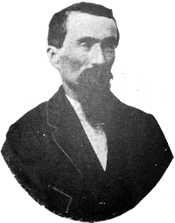December 19 — This morning we went on a little reconnoissance to a large field that slopes away from the river a little distance below the dam. The edge of the field and the river is fringed with a dense thicket, and is much higher ground than the Maryland side. Here and there were small open spaces in the undergrowth, and from one of these we plainly saw the Yankees’ infantry and a battery of artillery. In a very few moments after we spied them we had impressive information that they saw us about as plainly as we saw them, for they sent us their compliments in the form of a few shell from rifled guns. These were the first shell that ever flew over me. Though oblivion may blot all else from my memory, its darkest waters can never erase the remembrance of the tremor of fear that rushed all over me, and crept into every little corner about me, from my hat to my shoes, when I heard the frightful screaming whiz of the first shell. Somebody remarked that it was a twelve-pounder. Of course I am not used to hearing these things, but from the way it sounded to me I think it was about the size of a nailkeg — or a little larger.
It is wonderful how close to Mother Earth a raw recruit can get when he hears the “Hark from the tomb” of the first shell. When, the first shell passed over our heads to-day I laid so close to the ground that it seems to me I flattened out a little, yearning for a leave of absence. Our battery was not in position when the Yanks opened on us, and they did not even see our guns; but four of us Rebel curiosity-seekers had stuck our heads above the bank, which was the sole object that drew the enemy’s fire, with the expectation, I suppose, of finding bigger game behind the bushes.
The Second Regiment of Virginia Infantry was bivouacked in a field back of the one we were in, and in range and line of the Yankee shell. The men had their arms stacked, and were grouped around their fires, a great many with their blankets spread in the sunshine, but when the Yankee shell screamed across the field— one of which exploded over the regiment—it created a lively scene for a while, and caused a general stir among the men. Bivouac, equipage, and spread out blankets were ready to move in a very few moments after the report of the shell died away.
We did not reply to the fire of the Federal battery, but remaining on the field about an hour after they ceased firing, went back to camp about a mile from the dam.
This evening after dark we went above the dam on a hill for the purpose of firing on the riflemen and battery, while Jackson’s destroyers were working on the dam, but with their artillery the Yankees set a mill on fire on this side of the river near the dam. The burning mill threw a light on the dam almost as bright as day, which made it too hazardous for the destroyers to operate.
The light of the burning mill had no effect on our position, as a hill covered with thick woods screened us, and we were in perfect darkness, and a good distance from the mill. Yet I heard a bullet whiz over my head, and I have been wondering what the man was shooting at that fired it; and have come to the conclusion that it must have been fired by one of these angelic philanthropists of the North who has been taking lessons in religion from ” Uncle Tom’s Cabin” and has come down here to gratify his saintly prejudice by shooting at the Southern Confederacy in the dark.
We remained in position until we learned that the work on the dam had been abandoned, then we fell back a little distance and slept in a wood, without fire.



